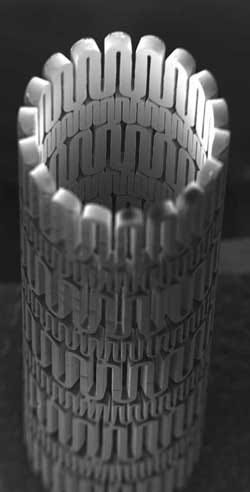How Lasers Are Changing MedTech
January 14, 2014
Advances in laser machining could aid polymer-based bioabsorbable stents in beating out metal stents in the medical device field. It might also allow for plenty of affordable, detailed polymer parts for point-of-care testing and devices.
|
A bioabsorbable stent from Resonetics. |
That's the message from Glenn Ogura, executive vice president at laser machining contract manufacturer Resonetics, who is scheduled to speak about his field next month at MD&M West in Anaheim, CA.
The enabling technology coming into play here is super-fast, fiber-based lasers, which Resonetics itself only started researching and utilizing in recent years.
Lasers focus light energy through a medium, usually a gas or a solid. For their mediums, the new super-fast lasers take advantage of the fiber optics materials that came out of the telecommunications revolution at the start of the millenium.
An excimer laser can take an hour to make a polymer stent; the new fast lasers take five minutes, Ogura says. They can also quickly machine tiny plastic wells to hold blood samples for point-of-care cancer tests.
Here's one hitch: A YAG laser can machine a metal stent in five minutes too. (It would turn a piece of polymer into something spaghetti-looking, Ogura says.)
But Ogura says the super-fast, fiber-based lasers have other advantages, too: "When you cut a metal stent with YAG laser, ... you have to go through a grinding, polishing phase afterwards. ... With the new lasers, you're done. No cleaning afterwards. ... There's no slag. There's no debris. It's ready to go."
Ogura thinks every new enabling technology needs a "killer app" that allows it be widely used. Excimer lasers, for example, found their application in high-density computer chips.
"I think bioabsorbable stents are going to be the killer app," Ogura says of the super-fast lasers.
The technology still needs to clear some hurdles.
While something used to etch beer bottles might only cost tens of thousands of dollars at most, the types of super fast lasers needed for producing stents presently run at $200,000 to $300,000 per laser, Ogura says. But he thinks the price will go down as they're used more widely.
The lasers have also not reached an ultraviolet wavelength, which would allow them to be used to machine metal.
"It's coming. There are definitely rumors in the industry of it being announced," Ogura says of fast, fiber-based UV lasers.
Ogura suspects everything from mobile phone circuit boards to LED displays to solar cells could become much cheaper once the new lasers hit the market. It would become more affordable to incorporate such components into medical devices.
"The life science industry stands to benefit from that," Ogura says.
Chris Newmarker is senior editor of MPMN and Qmed. Follow him on Twitter at @newmarker and Google+.
About the Author(s)
You May Also Like


.png?width=300&auto=webp&quality=80&disable=upscale)
